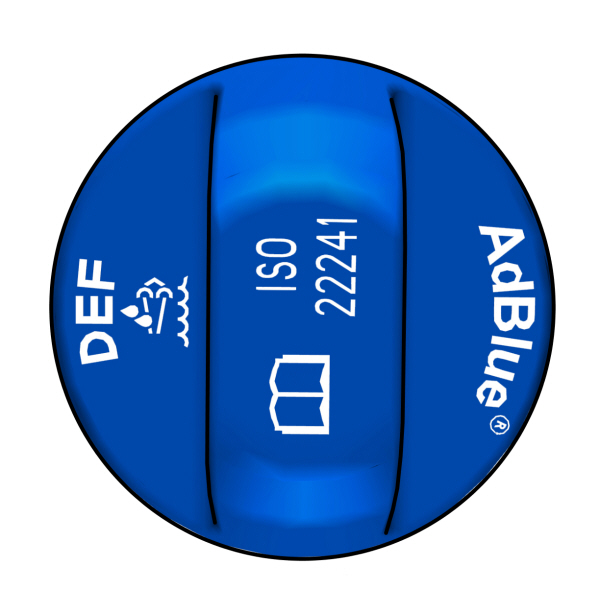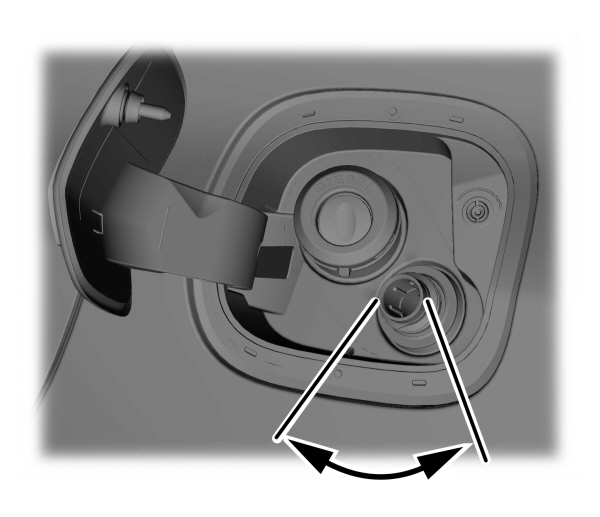This view of the Owner's Manual contains the very latest information, which may vary slightly from the printed Owner's Manual originally provided with your vehicle. It may also describe content that is not on or operates differently on your vehicle. Please consider the Owner's Manual originally provided with your vehicle as the primary source of information for your vehicle.

The information contained in this publication was correct at the time of release.In the interest of continuous development, we reserve the right to change specifications, design or equipment at any time without notice or obligation.No part of this publication may be reproduced, transmitted, stored in a retrieval system or translated into any language in any form by any means without our written permission.Errors and omissions excepted.
Copyright © 2024 Ford Motor Company
Selective Catalytic Reductant System - 2.0L EcoBlue, Vehicles With: 12.3 Inch Instrument Cluster Display Screen




 The warning lamp illuminates if the system detects the fluid level is low or if there is a system malfunction.
The warning lamp illuminates if the system detects the fluid level is low or if there is a system malfunction.
Your vehicle has a selective catalytic reductant system.This reduces exhaust emission levels by injecting AdBlue® into the exhaust system.The engine does not start if you tamper with or disable the selective catalytic reductant system.
For the system to correctly operate, you must maintain the fluid level.
Note:
When you switch the engine off the selective catalytic reductant system pump runs for a short period of time. This is normal.
AdBlue® Guidelines
- Only use AdBlue® certified to ISO-22241.
- Do not put AdBlue® in the vehicle fuel tank. This can cause engine damage not covered by the vehicle Warranty.
- Do not put fuel or any additives in the AdBlue® tank. This can cause damage not covered by the vehicle Warranty.
- Do not overfill the AdBlue® tank.
- Do not dilute with water or any other liquid.
- Do not re-use an empty fluid container.
- Do not store in direct sunlight.
- Store at temperatures between -5 °C (23 °F) and 20 °C (68 °F).
- Do not store fluid containers in your vehicle.
- The fluid is non-flammable, non-toxic, colorless and water-soluble.
- Immediately remove any residue on painted surfaces when filling with AdBlue®.
Filling the AdBlue® Tank

The AdBlue® tank filler pipe is next to the fuel tank filler pipe and has a blue cap.Fill the tank using a fluid pump at an AdBlue® filling station or an AdBlue® container.
Filling in Cold Climates
AdBlue® may freeze when the temperature is below
-11 °C (12 °F). Your vehicle has a preheating system which allows the fluid to operate below
-11 °C (12 °F).If you overfill the AdBlue® tank and the fluid freezes, it may cause damage not covered by the vehicle Warranty.
Note:
It may not be possible to fully fill the AdBlue® tank when the temperature is below
-11 °C (12 °F).
Note:
If the AdBlue® tank is frozen, it could not correctly display the fluid level or recognize when you fill the tank. The AdBlue® level updates when the tank completely thaws out.
Filling the AdBlue® Tank Using a Fuel Station Pump
 WARNING:
Do not allow diesel exhaust fluid (AdBlue) to come into contact with eyes, skin or clothing. Should the fluid come into contact with eyes, flush them with plenty of water and seek medical attention. Clean affected skin with soap and water. If swallowed, drink plenty of water and seek medical attention immediately.
WARNING:
Do not allow diesel exhaust fluid (AdBlue) to come into contact with eyes, skin or clothing. Should the fluid come into contact with eyes, flush them with plenty of water and seek medical attention. Clean affected skin with soap and water. If swallowed, drink plenty of water and seek medical attention immediately. WARNING:
Refill the diesel exhaust fluid (AdBlue) tank in a well-ventilated area. When removing the tank cap or a container cap, ammonia vapor may escape. Ammonia vapor is an irritant to the eyes, skin and mucous membranes. Inhaling ammonia vapor can cause burning to the eyes, throat and nose resulting in watering eyes or severe coughing.
WARNING:
Refill the diesel exhaust fluid (AdBlue) tank in a well-ventilated area. When removing the tank cap or a container cap, ammonia vapor may escape. Ammonia vapor is an irritant to the eyes, skin and mucous membranes. Inhaling ammonia vapor can cause burning to the eyes, throat and nose resulting in watering eyes or severe coughing. |
Filling the AdBlue® tank using a fuel station pump is similar to refueling your vehicle.
- Fully open the fuel filler door.

- Remove the AdBlue® tank filler cap.
- Fully insert the AdBlue® pump nozzle.

- Operate the AdBlue® pump nozzle within the area shown.
Note:
The pump nozzle shuts off when the tank is full.
- Slightly raise the AdBlue® pump nozzle and then slowly remove it.
- Replace the AdBlue® tank filler cap.Turn it clockwise until you feel a strong resistance and it clicks.
Do not attempt to start the engine if you have filled the AdBlue® tank with incorrect fluid. Incorrect fluid use could cause damage not covered by the vehicle Warranty. Have your vehicle checked as soon as possible.
Filling the AdBlue® Tank Using a Container
 WARNING:
Do not allow diesel exhaust fluid (AdBlue) to come into contact with eyes, skin or clothing. Should the fluid come into contact with eyes, flush them with plenty of water and seek medical attention. Clean affected skin with soap and water. If swallowed, drink plenty of water and seek medical attention immediately.
WARNING:
Do not allow diesel exhaust fluid (AdBlue) to come into contact with eyes, skin or clothing. Should the fluid come into contact with eyes, flush them with plenty of water and seek medical attention. Clean affected skin with soap and water. If swallowed, drink plenty of water and seek medical attention immediately. WARNING:
Refill the diesel exhaust fluid (AdBlue) tank in a well-ventilated area. When removing the tank cap or a container cap, ammonia vapor may escape. Ammonia vapor is an irritant to the eyes, skin and mucous membranes. Inhaling ammonia vapor can cause burning to the eyes, throat and nose resulting in watering eyes or severe coughing.
WARNING:
Refill the diesel exhaust fluid (AdBlue) tank in a well-ventilated area. When removing the tank cap or a container cap, ammonia vapor may escape. Ammonia vapor is an irritant to the eyes, skin and mucous membranes. Inhaling ammonia vapor can cause burning to the eyes, throat and nose resulting in watering eyes or severe coughing. |
Use containers that have a seal on the spout.
Always follow the manufacturer's instructions.
- Remove the fluid container cap.
- Place the spout on to the container and tighten it until you feel a strong resistance.

- Remove the AdBlue® tank filler cap.
- Insert the spout into the AdBlue® tank filler pipe until the seal on the spout fully seats.
- Pour the fluid into the tank.
Note:
The fluid stops flowing when the tank is full.
- Return the container to the vertical position slightly below the AdBlue® tank filler pipe.
- Allow any fluid remaining in the spout to drain back into the container.
- Remove the spout from the AdBlue® tank filler pipe.
- Remove the spout from the AdBlue® container and replace the cap.
- Replace the AdBlue® tank filler cap.Turn it clockwise until you feel a strong resistance and it clicks.
Do not attempt to start the engine if you have filled the AdBlue® tank with incorrect fluid.Incorrect fluid use could cause damage not covered by the vehicle Warranty. Have your vehicle checked as soon as possible.
Checking the AdBlue® Level
- Press the menu button on the steering wheel to enter the information display main menu.
- Select Select Screens.
- Select AdBlue® Info.
Checking the AdBlue® Range
- Press the menu button on the steering wheel to enter the information display main menu.
- Select Select Screens.
- Select AdBlue® Range.
AdBlue® Consumption
AdBlue® consumption is directly related to fuel consumption and is governed by many factors, for example driving style, high speed driving, stop-start driving, air conditioning usage, add-on accessories, payload and towing.The AdBlue® consumption may vary between 1% and 6% of the fuel consumption.
AdBlue® consumption is specified for a vehicle variant and not for a single car.
Selective Catalytic Reductant System Warning Lamp
 The warning lamp illuminates if the system detects the fluid level is low or if there is a system malfunction.
The warning lamp illuminates if the system detects the fluid level is low or if there is a system malfunction.If the warning lamp illuminates, the information display messages give you an indication whether the concern is fluid related or if there is a selective catalytic reductant system malfunction.If the warning lamp illuminates when your vehicle is moving, and the fluid is at a sufficient level, this indicates a system malfunction. Have your vehicle checked as soon as possible.
Selective Catalytic Reductant System Information Messages
AdBlue® Level
| Message | Action |
|---|---|
AdBlue® Low Range XXXX km Refill Soon | Indicates the approximate distance remaining before the AdBlue® tank becomes empty. Refill the AdBlue® tank as soon as possible. |
AdBlue® Low Range XXXX mi Refill Soon | |
AdBlue® Low No engine start in XXXX km | Indicates the approximate distance remaining before the AdBlue® tank becomes empty. The engine would not restart if you switch the ignition off. Refill the AdBlue® tank as soon as possible. |
AdBlue® Low No engine start in XXXX mi | |
AdBlue® level empty. Refill to start engine | The AdBlue® tank is empty. The engine would not restart if you switch the ignition off. Refill the AdBlue® tank. The minimum AdBlue® refill quantity required to restart the engine is available in the information display. |
Note:
When filling the AdBlue® tank from empty, there may be a short period before the increased AdBlue® level is registered.
Note:
If the AdBlue® tank freezes at low level, the displayed remaining distance could be reduced.
AdBlue® Malfunction
| Message | Action |
|---|---|
AdBlue® System Fault Service required | The system has malfunctioned.Have your vehicle checked as soon as possible. |
AdBlue® System No engine start in XXXX km | Indicates the approximate distance before a detected system fault would restrict the engine from starting. The engine would not restart if you switch the ignition off.Have your vehicle checked as soon as possible. |
AdBlue® System No engine start in XXXX mi | |
AdBlue® System Service required to start engine | The system has malfunctioned.Have your vehicle checked as soon as possible. |
Thank You For Your Feedback
